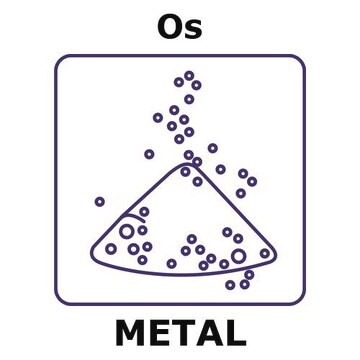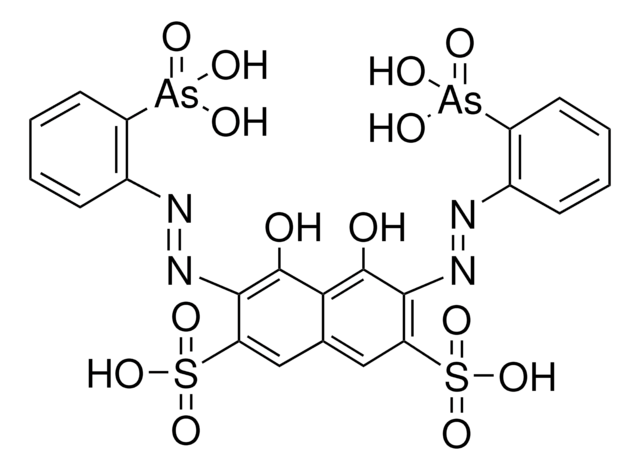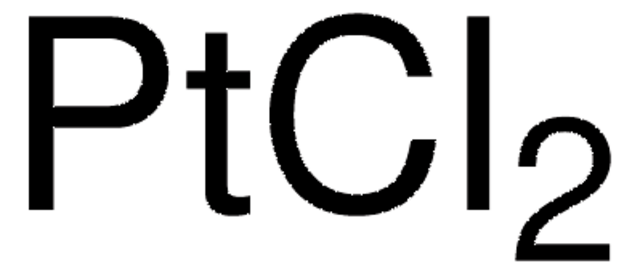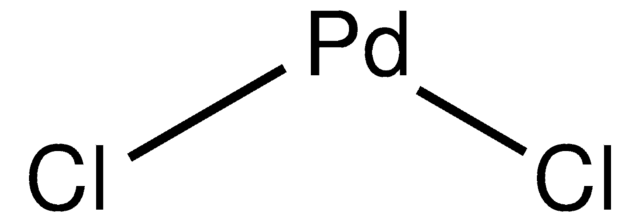All Photos(2)
About This Item
Empirical Formula (Hill Notation):
Os
CAS Number:
Molecular Weight:
190.23
EC Number:
MDL number:
UNSPSC Code:
11101711
PubChem Substance ID:
NACRES:
NA.23
Recommended Products
Quality Level
assay
99.9% trace metals basis
form
powder
resistivity
8.12 μΩ-cm, 20°C
bp
5027 °C (lit.)
mp
3045 °C (lit.)
density
22.61 g/cm3 (lit.)
SMILES string
[Os]
InChI
1S/Os
InChI key
SYQBFIAQOQZEGI-UHFFFAOYSA-N
Looking for similar products? Visit Product Comparison Guide
signalword
Danger
hcodes
Hazard Classifications
Eye Dam. 1 - Flam. Sol. 2 - Skin Irrit. 2 - STOT SE 3
target_organs
Respiratory system
Storage Class
4.1B - Flammable solid hazardous materials
wgk_germany
nwg
flash_point_f
Not applicable
flash_point_c
Not applicable
ppe
dust mask type N95 (US), Eyeshields, Gloves, type P3 (EN 143) respirator cartridges
Choose from one of the most recent versions:
Already Own This Product?
Find documentation for the products that you have recently purchased in the Document Library.
Customers Also Viewed
Kamrul Hasan et al.
Biochemical Society transactions, 40(6), 1330-1335 (2012-11-28)
Electrochemical communication between micro-organisms and electrodes is the integral and fundamental part of BESs (bioelectrochemical systems). The immobilization of bacterial cells on the electrode and ensuring efficient electron transfer to the electrode via a mediator are decisive features of mediated
Carole J R Bataille et al.
Chemical Society reviews, 40(1), 114-128 (2010-11-05)
Numerous synthetic protocols for producing syn-diols from the corresponding alkenes have been developed and published over recent years. It is the intent of the following tutorial review to present a concise summary of the main methods used to prepare syn-diol
Sunil A Patil et al.
Chemical communications (Cambridge, England), 48(82), 10183-10185 (2012-09-13)
Using the well-known exoelectrogen Shewanella oneidensis MR-1, an osmium redox polymer modified anode exhibited ca. 4-fold increase in current generation. Additionally, a significant decrease in the start-up time for electrocatalysis was observed. The findings suggest that the inherent extracellular electron
Vladimir B Arion et al.
Chemical communications (Cambridge, England), 48(68), 8559-8561 (2012-07-17)
A modified paullone ligand bearing a TEMPO free-radical unit (HL) and its ruthenium(II) and osmium(II)-arene complexes [M(p-cymene)(HL)Cl]Cl·nH(2)O (M = Ru, Os) exhibit high antiproliferative activity in human cancer cell lines.
Hideki Sugimoto et al.
Journal of the American Chemical Society, 134(46), 19270-19280 (2012-11-02)
For the synthesis of the 1,2-diols, cis-1,2-dihydroxylation of alkenes catalyzed by osmium(VIII) tetroxide (OsO(4)) is a powerful method. However, OsO(4) is quite toxic due to its highly volatile and sublimable nature. Thus, the development of alternative catalysts for cis-1,2-dihydroxylation of
Our team of scientists has experience in all areas of research including Life Science, Material Science, Chemical Synthesis, Chromatography, Analytical and many others.
Contact Technical Service














